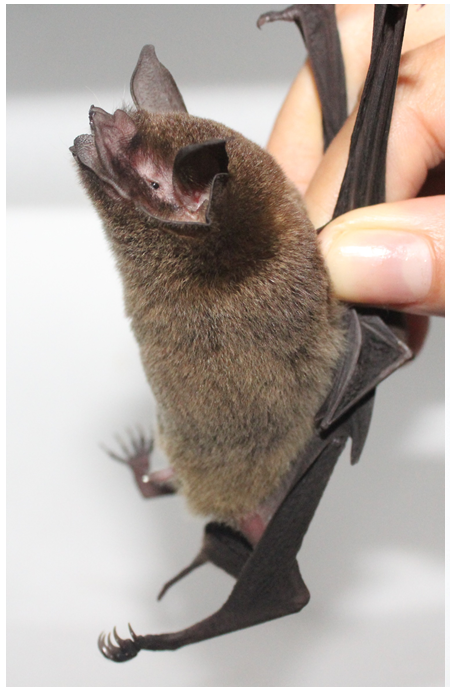Abstract
By means of manual capture and the description of morphological and morphometric characteristics, we report the record of two adult individuals of Pteronotus mesoamericanus in the Mamoní Valley Preserve on 27 April 2021. These records expand the known distribution of this species in the Isthmus of Panama and the Neotropical region.
References
Ávila-Flores, R y R. Medellín. 2004. Ecological, taxonomic, and physiological correlates of cave use by Mexican Bats. Journal of Mammalogy, 85:675-687. [https://doi.org/10.1644/BOS-127]
Chacón-Pacheco, J.J, J. Racero-Casarrubia y J. Ballestero-Correa. 2018. Nuevos registros de Pteronotus parnelli (Chiroptera, Mormoopidae) en el Departamento de Córdoba, Colombia. Boletín Científico Centro de Museos de Historia Natural, 22:121-127. [https://doi.org/10.17151/bccm.2018.22.1.11]
Cray, H. y G. D’Avignon. 2009. A Contribution to the Ecological Understanding of Bats in the Natural Metropolitan Park, Panama. McGill University, Canadá, in collaboration with: El Parque Natural Metropolitano.
Díaz, M.M., R.G. Solari, L.F. Aguirre y R.M. Barquez. 2021. Clave de identificación de los murciélagos neotropicales. Publicación especial #4-PCMA (Programa de conservación de los murciélagos de Argentina). Tucumán, Argentina.
Girón, L.E. 2020. Morfología, ecolocalización y uso de micro-hábitat de murciélagos del género Pteronotus (Chiroptera: Mormoopidae) en el Parque Nacional Barra Honda, Costa Rica. Tesis de posgrado, Titulo de Maestría Académica en Biología. Ciudad Universitaria Rodrigo Facio, Costa Rica.
Glover, A. M. y J.D. Altringham. 2008. Cave selection and use by swarming bat species. Biological Conservation, 141:1493-1504. [https://doi.org/10.1016/j.biocon.2008.03.012]
Hernández, D.I. 2017. Dinámica de ocupación de refugios por murciélagos en Pluma Hidalgo y Santa María Huatalco, Oaxaca. Tesis de posgrado, Titulo Maestría en Ciencias en Conservación y Aprovechamiento de Recursos Naturales, línea, patrones y procesos para la biodiversidad del neotrópico. Instituto Politécnico Nacional, Centro Interdisciplinario de Investigación para el Desarrollo Integral Unidad Oaxaca, México.
Hiller, T.R, M.G. Vollstädt, S.D. Brändel, R.A. Page y M. Tschapka. 2021. Bat–bat fly interactions in Central Panama: host traits relate to modularity in a highly specialized network. Insect Conservation and Diversity, 14: 686-699. [https://doi.org/10.1111/icad.12508]
IUCN. 2022. The iucn Red List of Threatened Species [Internet]. Version 2021-3., Solari, S. International Union for the Conservation of Nature. Disponible en: <https://www.iucnredlist.org>. [Consultado el 20 de junio de 2022]
Magalhães de Oliveira H.F, N.F. Camargo, D.R. Hemprich-Bennett, B. Rodríguez-Herrera, S.J. Rossiter. 2020. Wing morphology predicts individual niche specialization in Pteronotus mesoamericanus (Mammalia: Chiroptera). PLOS ONE, 15:5-21. [https://doi.org/10.1371/journal.pone.0232601]
López, M, G. Sagel y J. Araúz. 2022. Riqueza, abundancia y diversidad de murciélagos en los alrededores del hotel Summit Rainforest Resort y Golf Panamá, Provincia de Panamá. Revista Nicaragüense de Biodiversidad, 76: 1-21.
Reid, F.A. 2009. A field guide of the mammals of Central American and Southeast Mexico. Second Edition. Oxford University Press. New York.
Simmons, N.B. y T.M. Conway. 2001. Phylogenetic relationships of mormoopid bats (Chiroptera: Mormoopidae) based on morphological data. Bulletin of the American Museum of Natural History, 258:1-97.
Smith, J.D. 1972. Systematics of the chiropteran family Mormoopidae. Miscellaneous Publications of the Museum of Natural History University of Kansas, 56:1-132.
Taylor, M. 2019. Bats an illustrated guide to all species. Merlin D. Tuttle, Ivy Press. United Kingdom.
Torres-Flores, J. W, R. López-Wilchis y A. Soto-Castruita. 2012. Dinámica poblacional, selección de sitios de percha y patrones reproductivos de algunos murciélagos cavernícolas en el oeste de México. Revista Biología Tropical, 60:1369-1389.
Timm, R.M, R.K. Laval y B. Rodríguez. 1999. Clave de campo para los murciélagos de Costa Rica. San José: Departamento de historia natural, Museo Nacional de Costa Rica. San José, Costa Rica.
Tuttle, M.D. y D. Stevenson. 1982. Growth and survival of bats. Pp. 105-150, en: Ecology of Bats. (Kunz, T.H, eds). Springer, Boston, MA.
York, H.A, B. Rodríguez-Herrera, R. LaVal y R. Timm. 2019. Field keys to the bats of Costa Rica and Nicaragua. Journal of Mammalogy, 100:1726-1749.
Wilson, D.E. y R.A. Mittermeier (eds). 2019. Handbook of the mammals of the world. Vol. 9. bats. Lynx Edicions, Barcelona.

This work is licensed under a Creative Commons Attribution-NonCommercial-NoDerivatives 4.0 International License.
Copyright (c) 2022 UNIVERSIDAD NACIONAL AUTÓNOMA DE MÉXICO



